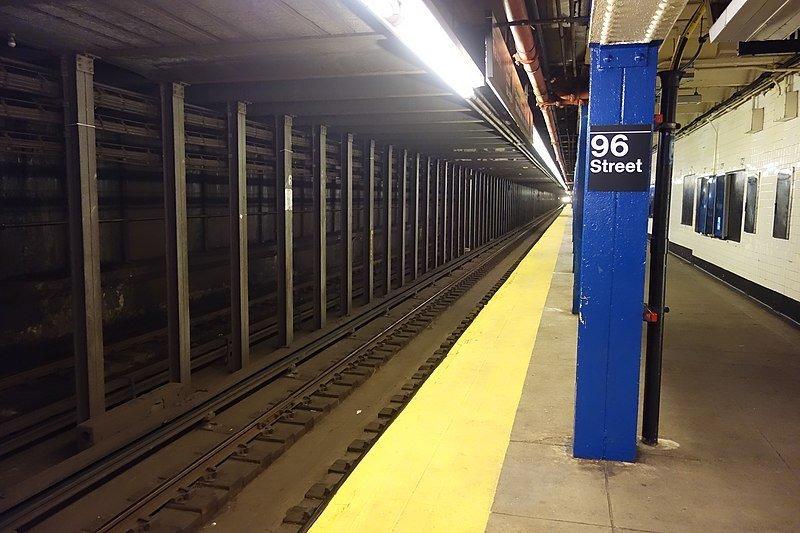
The subway station on 96th and Central Park West, c/o Tdorante10 via Wikimedia Commons
Amid the call for more safety measures in the subway in the wake of the tragic death of Upper West Sider Michelle Go, the MTA has released a 2019 report on the feasibility of doors and gates aimed at preventing people from being pushed onto the tracks. (The barriers would also deter or prevent suicides and accidental falls.) It determined, Patch was first to report, that full-height platform screen doors or half-height gates would be feasible in only one of the 14 Upper West Side subway stations, the 96th Street B/C station. The cost would be $31 million for doors and about $39 million for automatic gates at the station.
Advertisement
New York City has experienced the most transit assaults in 25 years.
Full-height platform screen doors and gates (which range between 4’6” feet to 6’ high) are being used in mass transit systems in cities throughout the world, including Tokyo, Delhi and Paris. In the U.S., full-height screen doors are often used on airport terminal trains — barriers that stand between passengers and the trains, with doors that open and close simultaneously with the train doors. Manhattan Borough President Mark Levine is one of those politicians pushing for billions of dollars to be spent on protective barriers in the city to prevent further tragedies.
The MTA report says that full-height screen doors are feasible in only 128 of 472 stations in the city. The biggest obstacles cited by the MTA are gaps between platform edges and trains, train door misalignment, column placement, ventilation, the age of the system and the narrowness of most of the platforms, which doesn’t allow for ADA-compliant wheelchair accessibility.
But Acting MTA Chair Janno Lieber says that despite the challenges, the agency is “studying it [the full-height platform screen doors] yet again. And we are interested in seeing whether there are opportunities to install it, especially in some of the more, the busier stations where you get a little more crowded.”
For news across the park visit EastSideFeed.com
Half-height barriers might be a better bet. The agency has determined there are some 40 to 100 stations where these gates could potentially be installed, and Lieber says he’d like to proceed with a pilot program.
Advertisement
The only station on the Upper West Side where the MTA report says the barriers are feasible is the 96th Street B and C train station, where the platforms are between 11’8” and 12’ wide.
Meanwhile, Lieber criticized Levine for lack of action regarding mental health issues in the city. Until last December, Levine was chair of the City Council Health Committee.
“What was going on when they spent billions of dollars on mental health that left us with the condition we’re seeing in the system?” Lieber said in a recent interview, according to CBS.





Lieber is right. Ideologues like Levine dance around the issues when it was people like him who were responsible for managing this underclass of kooks and criminals in the first place. Lieber is just trying to run a railroad.
In 100 years how many?
Back then we had laws
Back then we had psych facilities
So we don’t need sliding doors
We need people in jail or a mental facility
In Texas you go into a shelter or leave the city no camping allowed
Also try to keep the drug dealers out of the shelters
We DO NOT need doors or gates or barriers. We DO need strong leadership that will not be soft on crime and criminals. We need to arrest criminals and keep them in jail where they belong.
The mentally I’ll need to be in facilities where they cannot hurt anyone.
When are the people of NYC going to wake up??????
Typo……. Mentally ill
Soft on crime? Yes, lock up one for armed robbery, but remember, innocent until proven guilty in a “speedy” trial. Not one six months later. And no bail, but once again, a “speedy” trial.
No bail since a wealthy suspect can “buy” their way out and delay a trial ad ad infinitum.
But bail for a poor person who stole a candy bar, to languish in jail ad infinitum?
And NYC’s previous attempt to house the mentally was a “Snake pit.” An actual hell hole called Willowbrook. Look it up.
It’s defining, designing, the facility that’s the real problem. They should not be allowed to run loose both for their own protection, and others.
We have come no further than the ancient Romans with their barbaric games and spectacles for the masses in the Colosseum and Circus Maximus. We want and approve billions to be spent on being entertained by professional spectator sports from basketball and football — think of the billions poured into the upcoming Super Bowl, the broadcasting and media fanfare and half-time show — to auto, motorcycle and horse racing…but diverting billions to spend on new mental health facilities and programs for the mentally ill and billions diverted so courts can add judges, assistant district attorneys, court personnel and juries to actually prosecute ALL cases and move them in a timely manner to acquittal or sentencing….those billions are never to be found, much less demanded that it be found by Americans. Our political class and the media bloviate incessantly about societal ills; we make great theater of our search for solutions but it’s all a smokescreen. What we willfully choose instead is to spend our money on games, entertainment, and fluff. More schools and teachers; more court rooms and staff to work in them; more mental and medical facilities; more housing so people don’t live and die homeless and hungry on our streets and sidewalks – we tear our hair out searching for the solutions for these “urban problems” but ultimately, we just can’t find the money to address them in any consistent, sensible way. Where does all the money go and why can’t we ever find what we need to make the necessary changes?